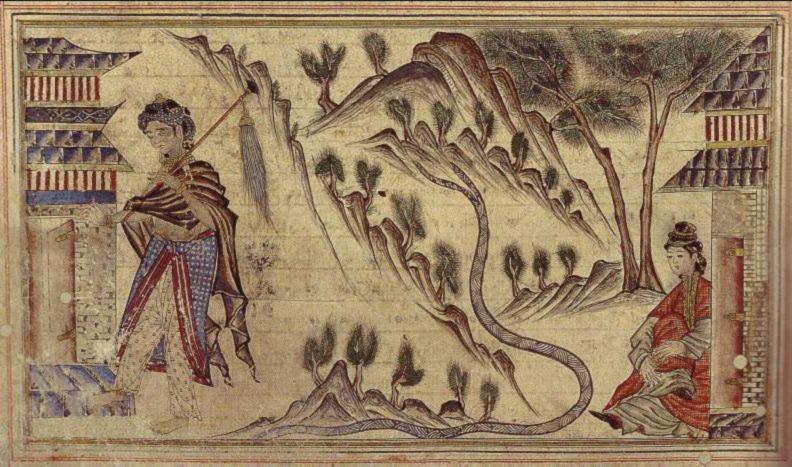Shop Amazon - Create an Amazon Baby Registry

Shop Amazon - Create an Amazon Baby Registry
An illustration in the 1305-14
Jami‛ al-Tawarikh
by Rashid al-Din.
Universal History
or Compendium of Chronicles
Ğāmi‛ al-tavārīḫ. Rašīd al-Dīn Fazl-ullāh Hamadānī
The mountains between India and Tibet,
with a female pilgrim in Indian dress

A larger image of 'The mountains between of India and Tibet, with a female pilgrim in Indian dress', Jami' al-Tawarikh, 1305-14.
Il-Khanid: Tabriz
Khalili Collection, MSS. 727, folio 22a
Fig. 182; p157 Rogers.
Fig. 42; K20 Blair.
Fig. 36; p254 Min Yong Cho.
Fig. 162 (cat. no. 7) Mountains between Tibet and India from the Jamiʿ al-Tawarikh (Compendium of Chronicles) by Rashid al-Din, Iran (Tabriz), 714/A.D. 1314-1315. Fol. 261r; ink, colors, and gold on paper. The Nasser D. Khalili Collection of Islamic Art, London (MSS 727)
7 Figs. 162, 174
Iran (Tabriz), A.H. 714/A.D. 1314-15
59 folios: ink, colors, and gold on paper
43.5 x 30 cm (17⅛ x 11¼ in.)
The Nasser D. Khalili Collection of Islamic Art, London (MSS 727)
Ghazan (r. 1295-1304), the seventh ruler of the Ilkhanid dynasty and the first to convert to Islam, commissioned his vizier, Rashid al-Din (1247-1318), to write the history of the Mongols.
During the reign of Ghazan’s brother and successor, Öljeitü (r. 1304-16),
this text developed into the earliest account of the world’s history and has since been known as the Jamiʿ al-tavarikh, or Compendium of Chronicles.
An addendum to the vizier's fifty-thousand-dinar endowment of his tomb complex in Tabriz stipulated that two copies of his work, one in Arabic and another in Persian,
should be transcribed every year. The pages from the Arabic manuscript here are from the earliest-known copy of this chronicle, completed in 131 5 and made under the author’s supervision.1
This work initially comprised four volumes.
The first, written for Ghazan, was an account of the Mongol rulers from Genghis Khan onward (see cat. nos. 17-19, 22—25, 27-31 for pages presumed to be from this volume).
The second volume covered Öljeitü’s life up to the time of writing (1310), together with the history of the Eurasian people.
Only the second half of the second volume survives, narrating the history of the ancient Iranian and Arabian kings, the prophet Muhammad and the caliphs, the Jews,
the non-caliphate rulers of Iran and Asia Minor, the Franks, the Indians, and the Chinese.2
The Edinburgh and Khalili manuscripts between them make up this section of the second volume.3
The two together contain over 200 folios; interspersed at various points in the text are 110 illustrations,
plus 80 portraits of Chinese emperors and their attendants.
The paintings seem to draw upon a wide range of sources including—but not limited to—pre-Mongol Persian and Arabic texts (both pre-Islamic and Islamic manuscripts),
Chinese scrolls and wood-block illustrations from books, Byzantine religious and historical manuscripts, and Crusader painting with its French Gothic style.4
Perhaps most significantly, non-Mongols are here recast in the guise of Mongols, with their characteristic features and costumes,
thereby in a sense uniting all of world history with that of the Mongols.
A case in point is the dramatic battle scene pictured in Mahmud of Ghazna’s Conquest of India (cat. no. 6, fig. 172), in which the tenth-century Turkic conqueror
(at left of center) is portrayed as a Mongol warlord, clothed in a silk robe decorated with golden clouds.
Nearly every painting reflects one or more sources of influence.
For example, the composition of The Birth of the Prophet Muhammad has been adapted from a Christian Nativity scene (cat. no. 6, fig. 130).
Its tripartite arrangement is a formula well known from thirteenth-century manuscript illustration associated with Baghdad.5
In The Death of Moses (cat. no. 7, fig. 174), the prophet lies in state in a manner related to comparable scenes in Byzantine manuscript illustration,6
while the mountain setting of Mount Jebo, Where Moses delivered his final sermon,
is rendered as a series of spiky triangulations reminiscent of Chinese landscape conventions as used, for example, in textiles.
Chinese influence in the Jamiʿ al-tavarikh is perhaps most evident in the depiction of landscape, mountainous landscape in particular,
which is the dominant theme of Mountains between India and Tibet.
This painting (cat. no. 7, fig. 162), which illustrates the section on India, not only incorporates Chinese conventions for the mountains;
it also draws on a variety of Asian sources in representing the two buildings (one based on a Nepalese, the other on a Chinese, model) and the two figures,
whose poses, costumes, and jewelry reflect Chinese, Tibetan, and Indian influences.7
In this way, the ingenious artists of the Jamiʿ al-tavarikh repeatedly transformed existing models, compositions,
and figural types to create new compositions that would recur in, or would influence, subsequent manuscript illustrations and drawings.
1. Blair1984, pp. 81-82; Blair 1995, pp. 12—13.
2. Blair 1995, p. 23. Volume 3 was a geneaology of ruling houses, volume 4. a geographical work.
3. D. T. Rice and Gray 1976; Blair 1995.
4. Blair 1995, pp. 46-54. See also Robert Hillenbrand’s chapter 6 above.
5. In the Mongol period this type of composition was already present in the double frontispiece from the Rasaʿil al-ikhwan al-safaʾ produced in Baghdad in 1287; see Ettinghausen 1962, pp. 98-101.
6. Blair 1995, p. 84.
7. Ibid., p. 77.
Source: pp. 137 & 245-246, The Legacy of Genghis Khan Courtly Art and Culture in Western Asia 1256 1353
Previous: The mountains of India, f21 Next: Battle of the Pandavas and the Kauravas, a scene from the Indian epic, the Mahabharata, f25a
Back to the Jami‛ al-Tawarikh of 1305-14


